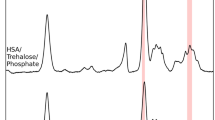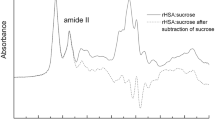Abstract
Purpose. The mobility of protein molecules in lyophilized protein formulations was compared with that of excipient molecules based on the spin-lattice relaxation time (T1) of each molecule determined by high resolution 13C solid-state NMR. The relationship between molecular mobility and protein stability is discussed.
Methods. Protein aggregation of lyophilized bovine serum -γ-globulin (BGG) formulation containing dextran was measured by size exclusion chromatography. The T1 of the BGG carbonyl carbon and dextran methin carbon in the formulation was determined by high resolution 13C NMR, and subsequently used to calculate the correlation time (τC) of each carbon. The spin-spin relaxation time (T2) of BGG and dextran protons was measured by pulsed NMR spectrometry, and the critical temperature of appearance of Lorentzian relaxation due to liquid BGG and dextran protons (Tmc) was determined.
Results. The τC of dextran methin carbon in BGG-dextran formulations exhibited a linear temperature dependence according to the Adam-Gibbs-Vogel equation at lower temperatures, and a nonlinear temperature dependence described by the Vogel-Tamman-Fulcher equation at higher temperatures. The temperature at which molecular motion of dextran changed was consistent with the Tmc. The τC of BGG carbonyl carbon exhibited a similar temperature dependence to the τC of the dextran methin carbon and substantially decreased at temperatures above Tmc in the presence of dextran. The temperature dependence of BGG aggregation could be described by the Williams-Landel-Ferry equation even at temperatures 20°C lower than Tmc.
Conclusions. High resolution 13C solid-state NMR indicated that the molecular motion of BGG was enhanced above Tmc in association with the increased global segmental motion of dextran molecules.
Similar content being viewed by others
REFERENCES
B. D. Herman, B. D. Sinclair, N. Milton, and S. L. Nail. The effect of bulking agent on the solid-state stability of freeze-dried methylprednisolone sodium succinate. Pharm. Res. 11:1467–1473 (1994).
L. Streefland, A. D. Auffret, and F. Franks. Bond cleavage reactions in solid aqueous carbohydrate solutions. Pharm. Res. 15:843–849 (1998).
M. Yoshioka, B. C. Hancock, and G. Zografi. Crystallization of indomethacin from the amorphous state below and above its glass transition temperature. J. Pharm. Sci. 83:1700–1705 (1994).
M. Yoshioka, B. C. Hancock, and G. Zografi. Inhibition of indomethacin crystallization in poly(vinylpyrrolidone) coprecipitates. J. Pharm. Sci. 84:983–986 (1995).
V. Andronis, M. Yoshioka, and G. Zografi. Effects of sorbed water on the crystallization of indomethacin from the amorphous state. J. Pharm. Sci. 86:346–351 (1997).
Y. Aso, S. Yoshioka, T. Otsuka, and S. Kojima. The physical stability of amorphous nifedipine determined by isothermal micro-calorimetry. Chem. Pharm. Bull. 43:300–303 (1995).
S. P. Duddu, G. Zhang, and P. R. Dal Monte. The relationship between protein aggregation and molecular mobility below the glass transition temperature of lyophilized formulations containing a monoclonal antibody. Pharm. Res. 14:596–600 (1997).
S. Yoshioka, Y. Aso, and S. Kojima. Dependence of the molecular mobility and protein stability of freeze-dried γ-globulin formulations on the molecular weight of dextran. Pharm. Res. 14:736–741 (1997).
S. Yoshioka, Y. Aso, Y. Nakai, and S. Kojima. Effect of high molecular mobility of poly(vinyl alcohol) on protein stability of lyophilized γ-globulin formulations. J. Pharm. Sci. 87:147–151 (1998).
S. Yoshioka, Y. Aso, and S. Kojima. The effect of excipients on the molecular mobility of lyophilized formulations, as measured by glass transition temperature and NMR relaxation-based critical mobility temperature. Pharm. Res. 16:135–140 (1999).
N. Parizel, G. Meyer, and G. Weill. Nuclear magnetic resonance lineshape studies of interpenetrating polymer networks. Polymer 12:2495–2502 (1993).
D. A. Torchia. The measurement of proton-enhanced carbon-13 T1 values by a method which suppresses artifacts. J. Magn. Reson. 30:613–616 (1978).
C. Ye, R. Fu, J. Hu, L. Hou, and S. Ding. Carbon-13 chemical shift anisotropies of solid amino acids. Magn. Reson. Chem. 31:699–704 (1993).
B. C. Hancock and G. Zografi. Characteristics and significance of the amorphous state in pharmaceutical systems. J. Pharm. Sci. 86:1–12 (1997).
I. M. Hodge. Physical aging in polymer glasses. Science 267:1945–1947 (1995).
B. C. Hancock, S. L. Shamblin, and G. Zografi. Molecular mobility of amorphous pharmaceutical solids below their glass transition temperatures. Pharm. Res. 12:799–806 (1995).
V. Andronis and G. Zografi. Molecular mobility of supercooled amorphous indomethacin, determined by dynamic mechanical analysis. Pharm. Res. 14:410–414 (1997).
V. Andronis and G. Zografi. The molecular mobility of supercooled amorphous indomethacin as a function of temperature and relative humidity. Pharm. Res. 15:835–842 (1998).
S. L. Shamblin and G. Zografi. Enthalpy relaxation in binary amorphous mixtures containing sucrose. Pharm. Res. 15:1828–1834 (1998).
B. C. Hancock and G. Zografi. The relationship between the glass transition temperature and the water content of amorphos pharmaceutical solids. Pharm. Res. 11:471–477 (1994).
L. S. Taylor and G. Zografi. Sugar-polymer hydrogen bond interactions in lyophilized amorphous mixtures. J. Pharm. Sci. 87:1615–1621 (1998).
M. L. Williams, R. F. Landel, and J. D. Ferry. The temperature dependence of relaxation mechanisms in amorphous polymers and other glass-forming liquids. J. Am. Chem. Soc. 77:3701–3707 (1955).
Author information
Authors and Affiliations
Corresponding author
Rights and permissions
About this article
Cite this article
Yoshioka, S., Aso, Y., Kojima, S. et al. Molecular Mobility of Protein in Lyophilized Formulations Linked to the Molecular Mobility of Polymer Excipients, as Determined by High Resolution 13C Solid-State NMR. Pharm Res 16, 1621–1625 (1999). https://doi.org/10.1023/A:1018973125010
Issue Date:
DOI: https://doi.org/10.1023/A:1018973125010




